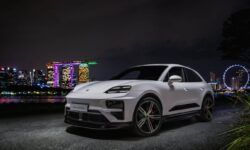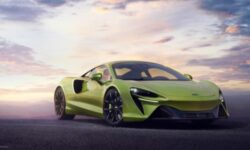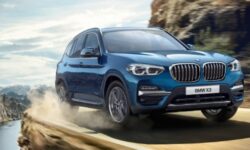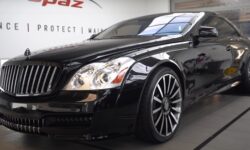Porsche reveals details of its all electric Taycan
 For the first purely electric Porsche, the engineers in Weissach developed a drive concept based on the principle of intelligent performance. They opted for a permanently excited synchronous motor in the Taycan. These are deployed in the Le Mans–winning 919 Hybrid, generating a permanent rotary motion that can be applied at any time without needing to be started—a technical feat achieved by having a permanently magnetized rotor forced into a rotary motion by the magnetic field of the stator.
For the first purely electric Porsche, the engineers in Weissach developed a drive concept based on the principle of intelligent performance. They opted for a permanently excited synchronous motor in the Taycan. These are deployed in the Le Mans–winning 919 Hybrid, generating a permanent rotary motion that can be applied at any time without needing to be started—a technical feat achieved by having a permanently magnetized rotor forced into a rotary motion by the magnetic field of the stator.

PSM electric motors are the turbos of the electric motor milieu. They boast both extremely high sustained performance and maximum efficiency. One motor powers the Taycan’s rear axle, the other the front wheels. Together they generate over 600 hp and are fed by batteries designed to provide five hundred kilometers of range. The Taycan sprints from 0 to 100 kmh in well under 3.5 seconds and tops 200 kmh in under 12. The PSM drives convert electrical energy into power with great efficiency, smoothness, and sustained output while generating relatively little heat. Performance figures making it virtually track-ready.

Intelligent performance is also delivered by the cooling system. Temperature sensors detect the cooling requirements in real time, while software ensures that the cooling water is immediately directed to the right spots. If the driver floors it, the cooling kicks into high gear as well, ensuring constant power.
Rather than installing heavy batteries, Porsche opts for fast charging. Electricity flows through some four hundred cells, which are connected both serially and in parallel. Each individual cell has a current of roughly 4 volts. Controlled by the battery management system, this all amounts to the 800-volt battery, in simplified terms. The objective of the Porsche fast-charging system: four hundred kilometers of range in about fifteen minutes. Aside from the short travel breaks for charging, another payoff of the 800-volt technology is the thinner cables in the car. That saves weight.

The new generation of charging stations is designed for 800-volt technology. But it’s also downward-compatible for all vehicles on the market with 400-volt technology. The Taycan is ready for the next four hundred kilometers in roughly fifteen minutes. Porsche employs the Combined Charging System as the standard in Europe and the US for alternating current (AC) charging and direct current (DC) charging. For Japan and China, Porsche will offer the local standards.
The company is pursuing three options: First, charging at home—possible with a charging station or inductively via a base plate in the floor. Second, charging in cities—possible through existing infrastructure. And third, charging along the main traffic arteries in Europe.
The construction and operation of some four hundred fast-charging parks by 2020 are important steps toward making electromobility viable for long-distance routes as well and thus establishing itself on the market. Every Ionity fast-charging park will have multiple charging points. They ensure that a vehicle can be charged every 100 to 150 kilometers along the European road network. As the number of electric vehicles grows, so too will the infrastructure. Thus by 2020, customers will gain access to thousands of brand- and capacity-independent “high-power charging” (HPC) points. The charging capacity of up to 350 kilowatts per charging point enables accordingly designed vehicles to achieve significantly shorter charging times compared to the systems available today.
Luxury Motor Press thinks:
With the interim information provided by Porsche prior to the cars official launch, a clear shift can be witnessed regarding future mobility and the acceptance of electric vehicles. The ability to envision infrastructure to sustain the challenges present for the electric vehicle is very positive. Maximizing the range and ensuring fast charging by Porsche with the Taycan could prove to set a benchmark and lead the way for other manufacturers.










